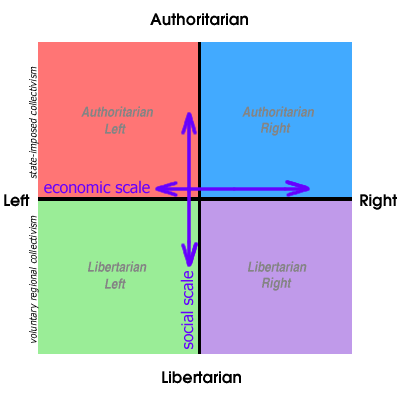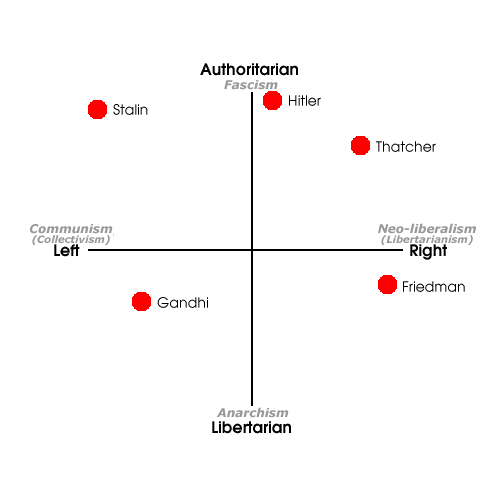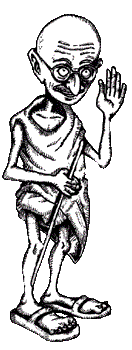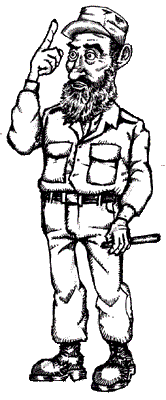About The Political Compass
™- 정치적 성향에 대해서
검사 받을 수 있는 곳 :
http://www.politicalcompass.org/questionnaire
아래의 글은 제가 검사받고 난뒤 나온 결과입니다 ㅇㅁㅇ)/
In the introduction, we explained the inadequacies of the traditional left-right line.
- 이 정보에서는, 우리는 전통적인 좌우파 세력의 불완전함을 해석했다.

If
we recognise that this is essentially an economic line it's fine, as
far as it goes. We can show, for example, Stalin, Mao Tse Tung and Pol
Pot, with their commitment to a totally controlled economy, on the hard
left. Socialists like Mahatma Gandhi and Robert Mugabe would occupy a
less extreme leftist position. Margaret Thatcher would be well over to
the right, but further right still would be someone like that ultimate
free marketeer, General Pinochet.
That
deals with economics, but the social dimension is also important in
politics. That's the one that the mere left-right scale doesn't
adequately address. So we've added one, ranging in positions from
extreme authoritarian to extreme libertarian.
-
만약 우리가 경제적인 라인을 본질적으로 허가한다면, 그것은 좋은 것이다, 좋은 방향으로 갈때까지. 예를들어, 우리는 스탈린,
Mao Tse Tung and Pol Pot과 같은 경제를 완전히 통제하는 위원회를 함께한 것들을 볼 수 있다, 극 좌파.
사회주의자 같은 Mahatma Gandhi and Robert Mugabe는 심한 것보다 약간 작은 좌파를 차지 할 것이다.
Margaret Thatcher 우파로 갈것이다, 그러나 그 위에 자유 시장상인인 General Pinochet와 같은 누군가가
여전히 우파로 남을 것이다.
경제학의 취급과 함께, 그러나 사회적인 규모는 또한 정치의 중요함이다. 이것은 단순한 적당히 알리는 좌우파의 세력이 아니다. 그래서 우리는 하나는 추가한다, 극 자유주의자와 권위주의의 위치를 정렬시켰다.

Both
an economic dimension and a social dimension are important factors for
a proper political analysis. By adding the social dimension you can
show that Stalin was an authoritarian leftist (ie the state is more
important than the individual) and that Gandhi, believing in the
supreme value of each individual, is a liberal leftist. While the
former involves state-imposed arbitrary collectivism in the extreme top
left, on the extreme bottom left is voluntary collectivism at regional
level, with no state involved. Hundreds of such anarchist communities
exisited in Spain during the civil war period
- 경제의 규모와 사회의 규모는
적당한 정치의 분석을 위한 요소중 하나이다. 사회적인 규모를 추가함으로써 너는 Stalin과 같은 자유주의자 좌파(개인보다
단체가 조금 더 중요하다고 보는)와 간디, 개인적인 것이 가장 중요하다고 믿는 자유주의의 좌파를 볼 수 있다. 이전에 극 좌파의
독단적인 집산주의가 state-imposed(국가에서 세금을 부과하다)를 포함하는 동안, 좌파의 가장 밑바닥은
지역적인 수준의 자발적인 집산주의를 하는 하고, 나라를 포함시키지 않았다. 무정부주의자들의 사회같은 다수가 시민 전쟁 기간동안
스페인에서 존재했다.
아래부터는 귀찮으므로 해석 안함.
You can also put Pinochet, who was prepared
to sanction mass killing for the sake of the free market, on the far
right as well as in a hardcore authoritarian position. On the
non-socialist side you can distinguish someone like Milton Friedman,
who is anti-state for fiscal rather than social reasons, from Hitler,
who wanted to make the state stronger, even if he wiped out half of
humanity in the process.
The chart
also makes clear that, despite popular perceptions, the opposite of
fascism is not communism but anarchism (ie liberal socialism), and that
the opposite of communism ( i.e. an entirely state-planned economy) is
neo-liberalism (i.e. extreme deregulated economy).

The
usual understanding of anarchism as a left wing ideology does not take
into account the neo-liberal "anarchism" championed by the likes of Ayn
Rand, Milton Friedman and America's Libertarian Party, which couples
law of the jungle right-wing economics with liberal positions on most
social issues. Often their libertarian impulses stop short of
opposition to strong law and order positions, and are more economic in
substance (ie no taxes) so they are not as extremely libertarian as
they are extremely right wing. On the other hand, the classical
libertarian collectivism of anarcho-syndicalism ( libertarian
socialism) belongs in the bottom left hand corner.
In
our home page we demolished the myth that authoritarianism is
necessarily "right wing", with the examples of Robert Mugabe, Pol Pot
and Stalin. Similarly Hitler, on an economic scale, was not an extreme
right-winger. His economic policies were broadly Keynesian, and to the
left of some of today's Labour parties. If you could get Hitler and
Stalin to sit down together and avoid economics, the two diehard
authoritarians would find plenty of common ground.
Your political compass
Economic Left/Right: -2.63
Social Libertarian/Authoritarian: -3.54
| Authoritarian |
| Left |
|
Right |
| Libertarian |
Show graph on separate page for printing
A brilliant conversation piece for your office or study ...
Join
24 caricatures of your most loved and loathed political figures in a
personalised colour certificate that you can load into your browser,
and print in moments.
It's beautifully
designed by political cartoonist Ralph Izzard and serves as a permanent
record of your position on the Compass, and the political company you
keep.
It's also a means of helping us to maintain and develop the concept and the site, while keeping it entirely advertising-free.
Now
you know where you are on The Political Compass™, you might like to
explore the ideas of those with similar (or wildly differing) views on
our
Reading List.
International Chart
A
diverse professional team has assessed the words and actions of
internationally known contemporary leaders to give you an idea of how
they relate to each other on the political compass.
We
regret the present exclusion of some major leaders, especially in the
developing world. This is due to our inability so far to contact
independent experts.
How You Can Help Us
A
great deal of effort lies behind the development of The Political
Compass, and the realisation of it in practical form. It has
occasionally come to our attention that other sites have tried to
exploit our work by copying it, adopting our name, or linking to us in
a dishonest fashion.
If you should come across any such sites, please let us know, so that we can take appropriate action.
A few critics believe that we should blow with prevailing political winds and narrow the actual parameters. Please see our FAQ 21.
Thanks from the Political Compass team.
ICONOCHASMS: How well do you know your political icons ?
New material is regularly added to The Political Compass - please keep coming back !
결론, 넬슨 만델라, 달라이 라마, 간디와 비슷한 정치적 성향을 띔.






